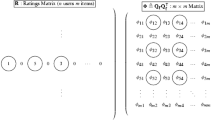Abstract
Top-\(N\) recommendation has drawn much attention from many portal websites nowadays. The classic item-based methods based on sparse linear models (SLIM) have demonstrated very good performance, which estimate a single model for all users. Lately, local models have been considered necessary since a user only resembles a group of others but not all. Moreover, we find that two users with similar tastes on one item group may have totally different tastes on another. Thus, it is intuitive to make preference predictions for a user via item-user subgroups rather than the entire feedback matrix. For elegant local top-\(N\) recommendation, this paper introduces a bi-clustering scheme to be integrated with SLIM, such that item-user subgroups are softly constructed to capture subtle preferences of users. A novel localized recommendation model is hence presented, and an alternative direction algorithm is devised to collectively learn item coefficient for each local model. To deal with the data sparsity issue during clustering, we conceive a refined feature-based distance measure to better model and reflect user-item interaction. The proposed method is experimentally compared with state-of-the-art methods, and the results demonstrate the superiority of our model.
Similar content being viewed by others
References
Aiolli, F.: A preliminary study on a recommender system for the million songs dataset challenge. In: Italian Information Retrieval Workshop, pp. 73–83 (2013)
Chen, Y., Zhao, X., de Rijke, M.: Top-\(N\) recommendation with high-dimensional side information via locality preserving projection. In: SIGIR, pp. 985–988 (2017)
Cremonesi, P., Koren, Y., Turrin, R.: Performance of recommender algorithms on top-\(N\) recommendation tasks. In: RecSys, pp. 39–46 (2010)
Deshpande, M., Karypis, G.: Item-based top-\(N\) recommendation algorithms. ACM Trans. Inf. Syst. 22(1), 143–177 (2004)
George, T., Merugu, S.: A scalable collaborative filtering framework based on co-clustering. In: ICDM, pp. 625–628 (2005)
Hofmann, T., Puzicha, J.: Latent class models for collaborative filtering. In: IJCAI, pp. 688–693 (1999)
Kabbur, S., Ning, X., Karypis, G.: FISM: factored item similarity models for top-\(N\) recommender systems. In: SIGKDD, pp. 659–667 (2013)
Karypis, G.: Evaluation of item-based top-\(N\) recommendation algorithms. In: CIKM, pp. 247–254 (2001)
Lee, J., Kim, S., Lebanon, G., Singer, Y.: Local low-rank matrix approximation. In: ICML, pp. 82–90 (2013)
Lee, J., Bengio, S., Kim, S., Lebanon, G., Singer, Y.: Local collaborative ranking. In: WWW, pp. 85–96 (2014)
Ning, X., Karypis, G.: SLIM: sparse linear methods for top-\(N\) recommender systems. In: IEEE ICDM, pp. 497–506 (2011)
O’Connor, M., Jon Herlocker, J.: Clustering items for collaborative filtering. In: SIGIR Workshops on Recommender Systems (1999)
Ungar, L.H., Foster, D.P.: Clustering methods for collaborative filtering. In: AAAI Workshops on Recommender Systems, pp. 114–129 (1998)
Xu, B., Bu, J., Chen, C., Cai, D.: An exploration of improving collaborative recommender systems via user-item subgroups. In: WWW, pp. 21–30 (2012)
Acknowledgment
This work was partially supported by NSFC under grants Nos. 61402494, 61402498, 71690233, NSF Hunan under grant No. 2015JJ4009, and ARC under grants DP150103071, DP150102728.
Author information
Authors and Affiliations
Corresponding author
Editor information
Editors and Affiliations
Rights and permissions
Copyright information
© 2017 Springer International Publishing AG
About this paper
Cite this paper
Wang, Y., Zhao, X., Chen, Y., Zhang, W., Xiao, W. (2017). Local Top-N Recommendation via Refined Item-User Bi-Clustering. In: Bouguettaya, A., et al. Web Information Systems Engineering – WISE 2017. WISE 2017. Lecture Notes in Computer Science(), vol 10570. Springer, Cham. https://doi.org/10.1007/978-3-319-68786-5_29
Download citation
DOI: https://doi.org/10.1007/978-3-319-68786-5_29
Published:
Publisher Name: Springer, Cham
Print ISBN: 978-3-319-68785-8
Online ISBN: 978-3-319-68786-5
eBook Packages: Computer ScienceComputer Science (R0)




